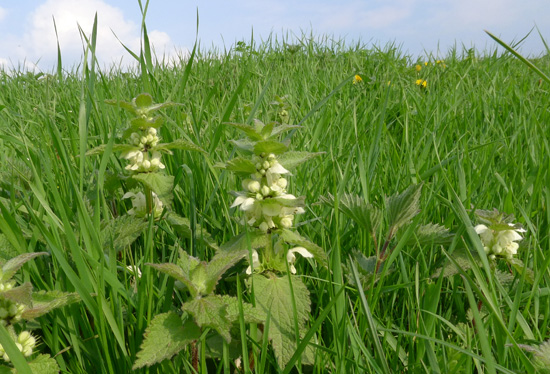
White Dead-Nettle, Lamium Album

White Dead-nettle, Lamium album has toothed, heart-shaped leaves that look very similar to the leaves of Stinging Nettle, Urtica dioica, a plant which is familiar to many. White Dead-nettles and Stinging Nettles also share other charcteristics such as having leaves arranged in alternate, opposite pairs on a stem with a square-shaped cross-section. Both plants are also hairy but, as suggested by its name, White Dead-nettle does not sting.

Despite the similarities maybe leading you to think otherwise, Dead-nettles and Stinging Nettles are not in the same family of plants. Dead-Nettles are in the family Lamiaceae, which also contains familiar herbs such as Mint, Basil, Thyme and Marjoram. White Dead-nettles grow to a height of 20-60cm and have distinctinve white flowers that cluster around the plant’s stem. They are generally found growing on waysides and on hedgebanks.

Even though White Dead-nettle is not an aromatic herb like some of its other family members, it is edible. Before the plant flowers, the young leaves and shoots are tender enough to eat raw. Later, when the leaves become tougher and possibly bitter, you can steam or lightly cook the leaves and eat as a green. Or you can add the leaves to soups as you would the leaves of Stinging Nettle.
Best Practice while Foraging
Please read the BSBI’s Code of Conduct for the Conservation and Enjoyment of Wild Plants for guidance on the best practice (and UK laws) relating to foraging for wild plant foods.
Disclaimer
This article is meant only as a guide and is largely a record of my recent forages. It is not a complete treatment of all edible plants that might be available. Nor does it provide a complete treatment of all poisonous plants that may also be present in the habitat where you find the above-mentioned plants. If you want to learn more about plant identification you should invest in some good field guides. The safest way to learn about edible wild plants is for someone who already has the knowledge to show you in person. Any foraging you do on your own is at your own risk.
The most important thing to remember when identifying wild foods is:
IF IN DOUBT, LEAVE IT OUT!
>Recommended Books for Further Reading
Related Articles on Paul Kirtley’s Blog
Yellow Archangel, Lamiastrum galeobdolon
Conopodium majus: Pignuts and How to Forage for them
Primrose, Primula vulgaris: Wild food?
7 thoughts on “White Dead-Nettle, Lamium Album”
I’m going to be on the look out for these, it’s a plant I was completely unaware of.
James
Hi James,
I’m sure there will be lots around your neck of the woods.
All the best,
Paul
Very handy article once more Paul. Thank you again.
You’re very welcome Kirkland. Thanks for the feedback.
I remember as a child, picking off the flowers and then brandishing the deflowered dead-nettle as a demonstration of my super ability to resist pain to my school mates. They soon cottoned on though.
It’s good to know of more practical uses for the white dead-nettle too. Thank you.
Paul, does the common stinging nettle not have flowers?
If not then I always thought the dead nettles were stinging nettles.
Stewart
at school we used to pick off the flowers and suck out the nectar. not exactly a life-saving tip but a nice sweet treat 😛